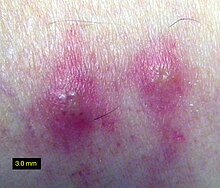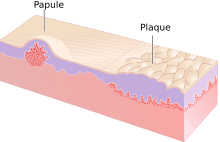


Cutaneous condition
Conditions of the human integumentary system constitute a broad spectrum of diseases, also known as dermatoses, as well as many nonpathologic states (like, in certain circumstances, melanonychia and racquet nails).[3][4] While only a small number of skin diseases account for most visits to the physician, thousands of skin conditions have been described.[5] Classification of these conditions often presents many nosological challenges, since underlying etiologies and pathogenetics are often not known.[6][7] Therefore, most current textbooks present a classification based on location (for example, conditions of the mucous membrane), morphology (chronic blistering conditions), etiology (skin conditions resulting from physical factors), and so on.[8][9]
Clinically, the diagnosis of any particular skin condition is made by gathering pertinent information regarding the presenting skin lesion(s), including the location (such as arms, head, legs), symptoms (pruritus, pain), duration (acute or chronic), arrangement (solitary, generalized, annular, linear), morphology (macules, papules, vesicles), and color (red, blue, brown, black, white, yellow).[10] The diagnosis of many conditions often also requires a skin biopsy which yields histologic information[11][12] that can be correlated with the clinical presentation and any laboratory data.[13][14]
Contents[hide] |
Where cutaneous conditions occur
Epidermis
Dermis
Subcutaneous tissue
Diseases of the skin
Diseases of the skin include skin infections and skin neoplasms (including skin cancer).
History
In 1572, Geronimo Mercuriali of Forlì, Italy, completed De morbis cutaneis (translated "On the diseases of the skin"). It is considered the first scientific work dedicated to dermatology.
Epidemiology
In World War I, over two million days of service are estimated to have been lost by reason of skin diseases alone.[26]
Approach to diagnoses
The physical examination of the skin and its appendages, as well as the mucous membranes, forms the cornerstone of an accurate diagnosis of cutaneous conditions.[27] Most of these conditions present with cutaneous surface changes termed "lesions," which have more or less distinct characteristics.[28] Often proper examination will lead the physician to obtain appropriate historical information and/or laboratory tests that are able to confirm the diagnosis.[27] Upon examination, the important clinical observations are the (1) morphology, (2) configuration, and (3) distribution of the lesion(s).[27] With regard to morphology, the initial lesion that characterizes a condition is known as the "primary lesion," and identification of such a lesions is the most important aspect of the cutaneous examination.[28] Over time, these primary lesions may continue to develop or be modified by regression or trauma, producing "secondary lesions."[1] However, with that being stated, the lack of standardization of basic dermatologic terminology has been one of the principal barriers to successful communication among physicians in describing cutaneous findings.[20] Nevertheless, there are some commonly accepted terms used to describe the macroscopic morphology, configuration, and distribution of skin lesions, which are listed below.[28]
Morphology
Primary lesions

- Macule - A macule is a change in surface color, without elevation or depression and, therefore, nonpalpable, well or ill-defined,[29] variously sized, but generally considered less than either 5[29] or 10mm in diameter at the widest point.[28]
- Patch - A patch is a large macule equal to or greater than either 5 or 10mm,[28] depending on one's definition of a macule.[1] Patches may have some subtle surface change, such as a fine scale or wrinkling, but although the consistency of the surface is changed, the lesion itself is not palpable.[27]
- Papule - A papule is a circumscribed, solid elevation of skin with no visible fluid, varying in size from a pinhead to either less than 5[29] or 10mm in diameter at the widest point.[28]
- Plaque - A plaque has been described as a broad papule, or confluence of papules equal to or greater than 1 cm,[28] or alternatively as an elevated, plateau-like lesion that is greater in its diameter than in its depth.[27]
- Nodule - A nodule is morphologically similar to a papule, but is greater than either 5[27] or 10mm in both width and depth, and most frequently centered in the dermis or subcutaneous fat.[28] The depth of involvement is what differentiates a nodule from a papule.[29]
- Vesicle - A vesicle is a circumscribed, fluid-containing, epidermal elevation generally considered less than either 5[29] or 10mm in diameter at the widest point.[28]
- Bulla - A bulla is a large vesicle described as a rounded or irregularly shaped blister containing serous or seropurulent fluid, equal to or greater than either 5[29] or 10mm,[28] depending on one's definition of a vesicle.[1]
- Pustule - A pustule is a small elevation of the skin containing cloudy[27] or purulent material usually consisting of necrotic inflammatory cells.[28] These can be either white or red.
- Cyst - A cyst is an epithelial-lined cavity containing liquid, semi-solid, or solid material.[29]
- Erosion - An erosion is a discontinuity of the skin exhibiting incomplete loss of the epidermis,[30] a lesion that is moist, circumscribed, and usually depressed.[20]
- Ulcer - An ulcer is a discontinuity of the skin exhibiting complete loss of the epidermis and often portions of the dermis and even subcutaneous fat.[30]
- Fissure - A fissure is a crack in the skin that is usually narrow but deep.[27]
- Wheal - A wheal is a rounded or flat-topped, pale red papule or plaque that is characteristically evanescent, disappearing within 24 to 48 hours.[29]
- Telangiectasia - A telangiectasia represents an enlargement of superficial blood vessels to the point of being visible.[27]
- Burrow - A burrow appears as a slightly elevated, grayish, tortuous line in the skin, and is caused by burrowing organisms.[27][28]
Secondary lesions
- Scale - dry or greasy laminated masses of keratin[28] that represent thickened stratum corneum.[27]
- Crust - dried serum, pus, or blood usually mixed with epithelial and sometimes bacterial debris.[29]
- Lichenification - epidermal thickening characterized by visible and palpable thickening of the skin with accentuated skin markings.[1]
- Excoriation - a punctate or linear abrasion produced by mechanical means (often scratching), usually involving only the epidermis but not uncommonly reaching the papillary dermis.[28]
- Induration - dermal thickening causing the cutaneous surface to feel thicker and firmer.[27]
- Atrophy - refers to a loss of tissue, and can be epidermal, dermal, or subcutaneous.[28] With epidermal atrophy, the skin appears thin, translucent, and wrinkled.[27] Dermal or subcutaneous atrophy is represented by depression of the skin.[27]
- Maceration - softening and turning white of the skin due to being consistently wet.
Configuration
"Configuration" refers to how lesions are locally grouped ("organized"), which contrasts with how they are distributed (see next section).
- Agminate
- Annular
- Arciform or arcuate
- Circinate
- Digitate
- Discoid
- Figurate
- Guttate
- Herpetiform
- Linear
- Nummular
- Mamillated
- Reticular or reticulated
- Serpiginous or gyrate
- Stellate
- Targetoid
- Verrucous
Distribution
"Distribution" refers to how lesions are localized. They may be confined to a single area (a patch) or may exist in several places. Several distributions correlate an anatomical reference. Some correlate with the means by which a given area becomes effected. For example, contact dermatitis correlates with locations where allergen has elicited an allergic immune response. Varicella Zoster Virus is known to recur (after its initial presentation as Chicken Pox) as Shingles. Chicken Pox appears nearly everywhere on the body but Shingles tends to follow one or two dermatomes. (For example, the eruptions may appear along the bra line, on either or both sides of the patient.)
- Generalized
- Symmetric (one side mirrors the other)
- Flexural (Front of the fingers)
- Extensor (back of the fingers)
- Intertriginous
- Morbilliform
- Palmoplantar (palm of the hand, bottom of the foot)
- Periorificial
- Periungual (under a finger or toe nail)
- Alopecia (hair loss)
- Blaschkoid
- Photodistributed (places where sunlight reaches)
- Zosteriform or dermatomal (associated with a particular nerve)
Other related terms:
- Collarette
- Comedo
- Confluent
- Eczema (a type of dermatitis)
- Granuloma
- Livedo
- Purpura
- Erythema (redness)
- Horn (a cell type)
- Poikiloderma
Combined (conjoint) terms (maculopapular, papuloerosive, papulopustular, papulovesicular, papulosquamous, tuberoulcerative, vesiculobullous, vesiculopustular) are used to describe eruptions that evolve from one type of lesion to the next so often appear as having traits of both, when transitioning[citation needed].
Histopathology
- Hyperkeratosis
- Parakeratosis
- Hypergranulosis
- Acanthosis
- Papillomatosis
- Dyskeratosis
- Acantholysis
- Spongiosis
- Hydropic swelling
- Exocytosis
- Vacuolization
- Erosion
- Ulceration
- Lentiginous
See also
- Dermatology
- List of dermatologists
- List of cutaneous conditions^ King, L.S. (1954). "What Is Disease?". Philosophy of Science 21: 193–203.





No comments:
Post a Comment